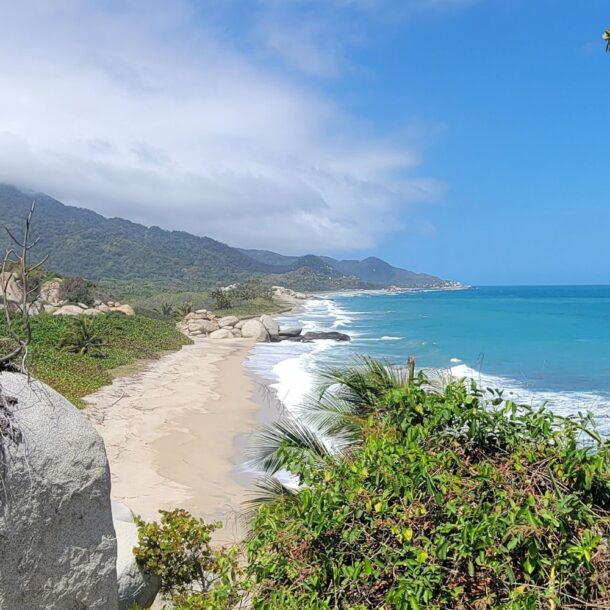
Recent Posts
Categories
Spoiler Alert: My take on Colombia is 10/10 highly recommended.
I’m sure I’m supposed to save the best for last but no sense in waiting to tell you the obvious. Colombia was a whole vibe. While my month in Colombia mainly took place in three cities – Medellin, Guatape, and Santa Marta – I’m also sharing tons more details about the country below.
Here’s what you need to know and the top things to do when planning your visit to Colombia.
Colombia is a diverse and vibrant country located in South America that has become an increasingly popular destination for American travelers, especially since the pandemic. Known as the “gateway to South America,” Colombia’s natural landscapes are magnificent and its cultural heritage is as rich as the day is long, possibly even more so. The people of Colombia are warm, welcoming, and super helpful which is good news for first-time visitors.
When it comes to culture, the spirit of Colombia is reflected in its food, music, and traditions. It is also home to several indigenous communities that have their own unique customs and languages.
Although the country was once infamous for political- and drug-related violence, Colombia has worked diligently to turn things around. That said, it’s still important to be aware of certain aspects of the country to ensure a safe and enjoyable trip. Colombia has made significant progress in terms of security in recent years, but there are still some areas that should be avoided due to the risk of violence and crime.
Overall, tourists visiting Colombia should approach their trip with an open mind and a sense of adventure, while also being mindful of the potential risks and taking appropriate precautions.
Listed below are several of the most popular cities you’ll hear people talk about when thinking of Colombia.
With a population of 8 million, Colombia’s capital and largest city, Bogotá, is a sprawling metropolis with a mix of modern amenities and historical attractions. While the city is a bit gritty and crowded in certain areas, it’s still worth visiting at least once. If you’re looking for bustling Latin American city vibes, Bogotá is the city for you.
Visitors can explore colonial-era architecture in the historic La Candelaria district or enjoy the city’s thriving arts and culture scene. Colorful murals adorn the walls of buildings all over the city, which is perfect for a street art tour.
The nearby Monserrate mountain delivers stunning views of the city if you’re up for the hike. Be mindful, however, that the hike can take between 2-4 hours and you can only enter the trail in the morning so plan accordingly.
Medellin is Colombia’s second-largest city, with 2.6 million residents. Known as the “City of Eternal Spring” due to its pleasant year-round weather, Medellín has undergone a major transformation in recent years. It is now considered one of the most innovative and dynamic cities in Latin America. It also ranks as one of the best places for digital nomads to temporarily call home.
Medellín is located in the Aburrá Valley and surrounded by the Andes Mountains on all sides. No matter where you are in the city, you can’t miss the lush green landscape. Having spent a month here, I fall in love with it all over again just thinking about it.
Visitors can take a ride on the city’s famous cable car system or visit the nearby coffee-growing region. One of my favorite activities here was our visit to Guatape, but we’ll talk more about that later.
Tourist Tip: Contrary to popular opinion, many Colombians are not proud of their affiliation with the infamous Pablo Escobar. Although you can easily find Pablo Escobar tours, the majority of locals don’t want to be reminded of this dark time in their country’s history. There’s a small minority of people who still respect Escobar, but most locals aren’t interested in discussing your interest in the drug lord. In other words, skip the Escobar talk and get to know Medellin and Colombia for yourself.
Cartagena’s population is modest at 1 million residents when compared to other destinations in Colombia. Located on the country’s Caribbean coast, Cartagena is a picturesque city with a rich history that dates back to the colonial era. When most people think of the colorful aesthetic of Colombia, they’re usually thinking of Cartegena, whether they know it or not.
Take a stroll through the city’s charming Old Town, swim in the crater of El Totumo volcano, or relax on one of several nearby beaches and islands.
Although I’m rarely a fan of speaking negatively about a destination, as a major tourist city, Cartagena has an unfortunate reputation for tourist-targeted pickpocketing and bag snatching. However, don’t count this city out as that could happen anywhere.
Cali is the “Salsa Capital of the World,” and is a lively and energetic city with a strong cultural identity. Located in southwest Colombia, Cali’s population of 2.2 million is a blend of Indigenous, African, and Spanish traditions.
Dance your heart out in one of the city’s many salsa clubs, explore museums and historical sites, or take a trip to nearby natural attractions like the Farallones de Cali National Park. The city also has its version of Brazil’s famous Christ the Redeemer statue – El Cristo Rey.
While the city may not have as many attractions as other cities in Colombia, Cali still has plenty to keep you entertained during your stay. If you’re a fan of ornate churches, be sure to Ermita Church in Cali’s city center.
These are just a few examples of the major cities in Colombia, each with its own unique character and attractions.
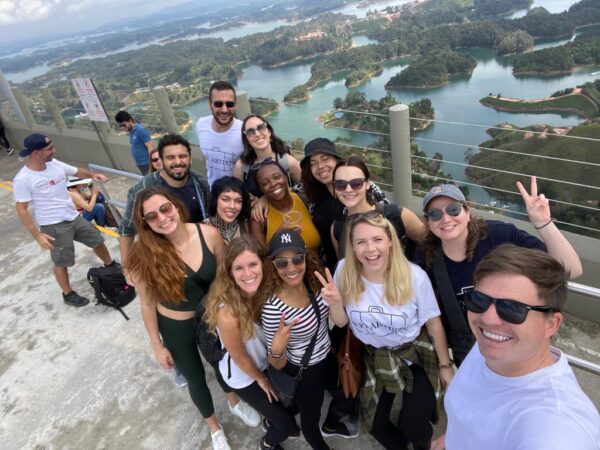
Whether you’re a first-time visitor or a seasoned traveler, there is always something new and exciting to discover in Colombia. From exploring historic sites to the most beautiful beaches, Colombia is a wonderful destination whether you want adventure or relaxation.
Grab a cup of Colombian coffee and find inspiration in all that this incredible country has to offer.
A two-hour bus ride from Medellin is all it takes to get to this popular destination. We found a private tour that met our group near where we were staying in the El Poblado area, which allowed us a little grace for a slightly late start and the ability to stop at a roadside market on the way for breakfast.
The Rock of Guatapé (Spanish: El Peñól de Guatapé) is a giant rock that sits in the middle of man-made waters and takes 659 steps to climb to the top, 650+ feet from the base.
Even though I was determined to make it, don’t think I didn’t wonder at least once if I was going to be able to. In reality, it took less than 30 minutes to get to the top, even with catch-my-breath breaks along the way. It took longer to come down, mainly because of visitor jams in parts of the climb where there’s only one way up and one way down. Don’t sleep on the walk down either. My legs were shaky for at least the next hour from trying not to miss a step on the journey back to the bottom.
Either way, the views were epic. The micheladas were DELICIOUS. And having this butterfly land smack dab in the middle of my photo session was all the confirmation I needed to know a change of scenery is good for the soul.
After climbing the rock, we eventually wandered the streets of Guatape, had lunch at a local restaurant, took a 1-hour boat ride, and ended the day with Colombian cocktails and window shopping (I gave up the need for souvenir things from every destination I visit a while ago).
A perfect but very long day. If you want a challenge or just love the idea of experiencing a colorful town, this should definitely be on your list when in/around Medellin.
I’m pretty sure a little piece of my heart was left behind in this beautiful beach town. After a few weeks in the valley city of Medellin, the group decided Santa Marta would be the destination for our weekend getaway.
A quick 1-hour flight, Santa Marta is on the northern coast of the country, a 4-hour drive northeast from Cartagena. We took an early morning flight from Medellin (MDE) to Santa Marta (SMR) and landed before most businesses were open, which was nice because it gave us a whole day to explore before checking in. I should also mention that my flight on Viva Airlines was only $48 RT! A one-hour direct flight to some of the most beautiful beaches for less than the cost of a dinner and drinks back home?! Sign me up over and over again.
The highlight of Santa Marta was hands down exploring Parque Tayrona. It was a journey to get there on our own – I’d personally recommend going through a tour company – but after the hour-long drive, we made it and I’m so glad we did. Two and a half hours of walking and stopping along the way through an actual jungle were amazing. The best part of the hike was ending up at each beach stop on the trail. Monkey lovers, this place is definitely for you. Same for my nature lovers.
One of my Instagram friends, a friend in real life, said it looked like Jurassic Park lol. They’re kind of right though. The most beautiful, lush mountain-meets-ocean combination I’ve ever seen. The journey through the jungle isn’t easy, but if you’re looking for a challenge (and to hit your daily step goal x2), it’s more than worth it.
On the last of the 3-day trip, we booked spots on a sailboat for a boat and beach day. If Parque Tayrona was first on my list of must-do activities, this boat ride is a very close second. I didn’t make the arrangements (thanks Jord), but between the captain, amazing lunch (included with ticket), and private-ish beach vibes, it was an absolutely perfect day. Docking at the marina that afternoon just in time to head to the airport to fly back to Medellin… because I like to play the game of whether or not I’ll make my flight from time to time.
Luckily, I made it with time to spare though.
According to the Colombian Tourism Board, Palenque is “the first ‘free town’ in the Americas, Palenque founded by those who fled a life of slavery in colonial times, has been preserved intact in Colombia. It’s a unique place, famous for its culture, language, gastronomy, and, of course, its history.”
The Palenque de San Basilio village was proclaimed Masterpiece of the Oral and Intangible Heritage of Humanity by UNESCO in 2015. In the village of Palenque de San Basilio, most of its inhabitants are Black and still preserve customs and language from their African ancestors. Here, you’ll find the beautiful palenqueras, whose beautiful and colorful garb has become synonymous with Colombia.
While I have yet to visit myself, I’ve heard nothing but good things that have visited time and time again. Palenque is a great reason to extend your stay by a few days when visiting Cartagena, only a one-hour drive away.
Once one of the most dangerous neighborhoods in the world, this area is now a destination for visitors with shopping, street murals/food/art, dancers, and walking tours through a still-populated historic part of the city.
Though the country has had quite an interesting, and sorted, history with gang and drug violence, it does acknowledge its past through various education tours and museums. Comuna 13 is one such neighborhood, which is now considered one of the safest suburbs of Medellin.
A visit to Comuna 13 is fairly easy to navigate via rideshare or public transportation. There are also free walking tours available, although the guides do work on tips. Fair warning, to really get the best views in Comuna 13 requires a good bit of walking up the paved pathways they’ve created over the years. There are escalators up to a certain point, but eventually, it’s all on foot to experience the rest of the walking tour. Either way, it’s a great way to explore a little bit of food, have a cocktail (or three), try fresh fruit and fruit juices, buy a new piece of art, or souvenir coffee to remember your Colombian adventures.
If you can visit during the week, that’s the best way to avoid crowds. However, going early on Saturday is a great way to get the best of Colombia’s music, food, and fun before it gets too packed later in the day.
If you are into getting dirty and/or trying new sports, Tejo is Colombia’s national sport. Think of throwing a rock-like disc into a mud goal area and hoping to strike the right spot to blow up the Tejo pouch (a gunpowder-filled packet). Best for those with a group, but you may also be able to drop into another group. Our experience was great. Check out @tejo_in_medellin on Instagram for more information.
If you’re a part of my podcast community, you know this already, but for those that don’t, my adventures in Colombia stemmed from my decision to take on some work with a new remote work and travel program startup company, WiFi Artists. Outside of my love of travel, I’m equally a marketing/strategy/brand development nerd, so building businesses is the thing I’d be doing even if I could do anything in the world.
If you love rain, this is the perfect place to visit. If you don’t, well you have a decision to make. I’ve lived in many places and have yet to find a city that experiences daily rain like this. Granted, if you’re prepared with an umbrella, who cares, but if rain affects your mood and/or you’re not prepared for it, you can definitely get caught in a daily downpour. I complained about the rain more than I should have while I was there. After all, that’s part of the reason for the naturally lush greenery of Medellin. Forgive me, Mother Nature.
The silver lining about these brief rain sessions each day? The amazing rainbows that peek out of the mountains once the rain settles down. Absolutely gorgeous.
With Colombia growing in popularity by the day, so too are the number of options for places to stay. This round-up of hotels is a great place to start when you want a beautiful getaway in this lush green country.
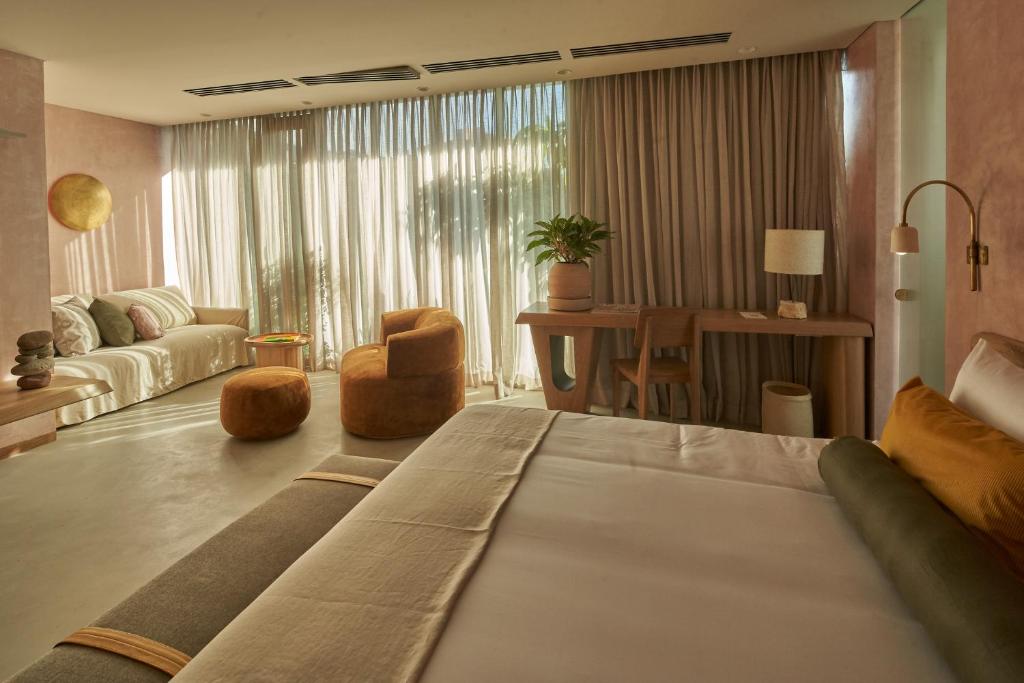
23 Hotel is a beautiful work of art that stands out among the sea of buildings in Medellin. This boutique hotel is for the aesthetically minded who also want a luxury stay in the heart of the city. The amenities of this gorgeous hotel include an outdoor swimming pool, hot tub, shared lounge, a terrace, and a restaurant. Rated a 5-star accommodation, room features include dreamy modern decor that brings nature indoors, a flat-screen TV, free wifi, and room service on speed dial.
The hotel’s location is rated a 9.5 on booking.com, making it the perfect option to be centrally located. Nearby, you’ll find popular attractions such as El Poblado Park, Lleras Park, and The Dancer’s Park. The Pablo Escobar Museum along with several other museums are also a short drive away via Uber.
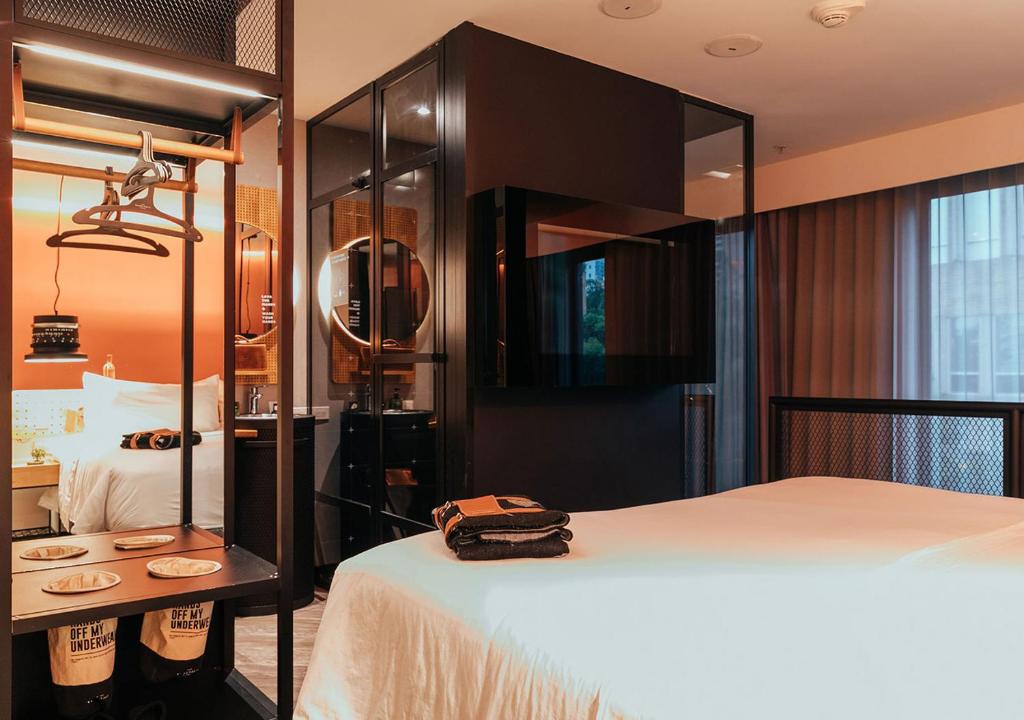
The Click Clack Hotel has locations in Bogota and Medellin (pictured above). Its Medellin location is situated in El Poblado, a popular area in the city for visitors to stay and play. With only 119 rooms, this intimate stay offers a range of room options from standard rooms to spacious suites. In addition to standard amenities like free wifi, a private bathroom, and a desk to get work done, select rooms also have a balcony. It’s truly a creative’s dream place to stay.
Aside from its sleek design, the hotel has a rooftop pool and bar with some of the best mountain views of Medellin. The outdoor green lobby features five exclusive restaurants that offer everything from healthy eats to Thai and Greek cuisine.
Within walking distance are El Poblado Park and Lleras Park. You’ll also have plenty to choose from as it relates to bars, restaurants, and nightlife, which are within walking distance or a short ride away via taxi or Uber.
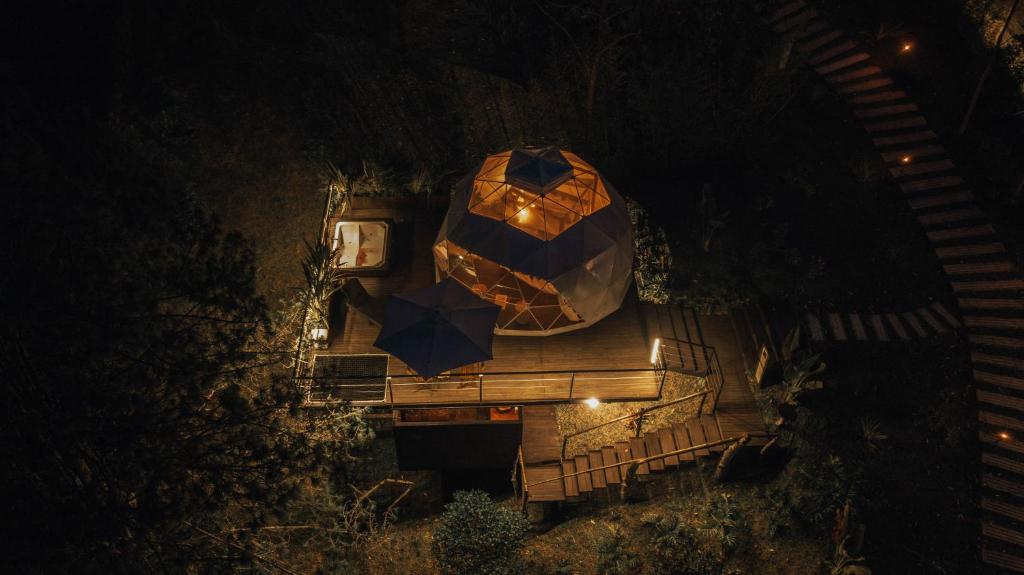
For a unique stay while you’re visiting Guatapé, BubbleSky Glamping is a beautiful property that takes sleeping under the stars to another level. These recently renovated luxury tents in Guatapé are an epic way to get off the grid for a few days. Whether you’re traveling with your partner or on a solo vacation, BubbleSky Glamping Guatapé is a must-add for your itinerary.
Each luxury tent unit is equipped for a luxury glamping experience with outdoor furniture. There’s also a dining area and fully equipped kitchen with a fridge and minibar. Enjoy continental breakfast on the property and, as an added bonus, plan to have the staff pack you a lunch for day excursions or off-site activities.
Property features include a hot tub, sun terrace, free wifi, private parking, picnic area, and a bicycle rental service. Surrounding the property is a beautiful garden along with barbecue facilities.
This is a great option if you plan to visit Piedra del Peñol, located only 2.3 miles. Since this popular attraction is about a 2-hour drive from Medellin, it’s worth considering an overnight stay. A few hiking options are also available nearby, and staff can help you determine the best trail for you.
The nearest airport is José María Córdova International Airport, 34 miles from BubbleSky Glamping Guatapé.
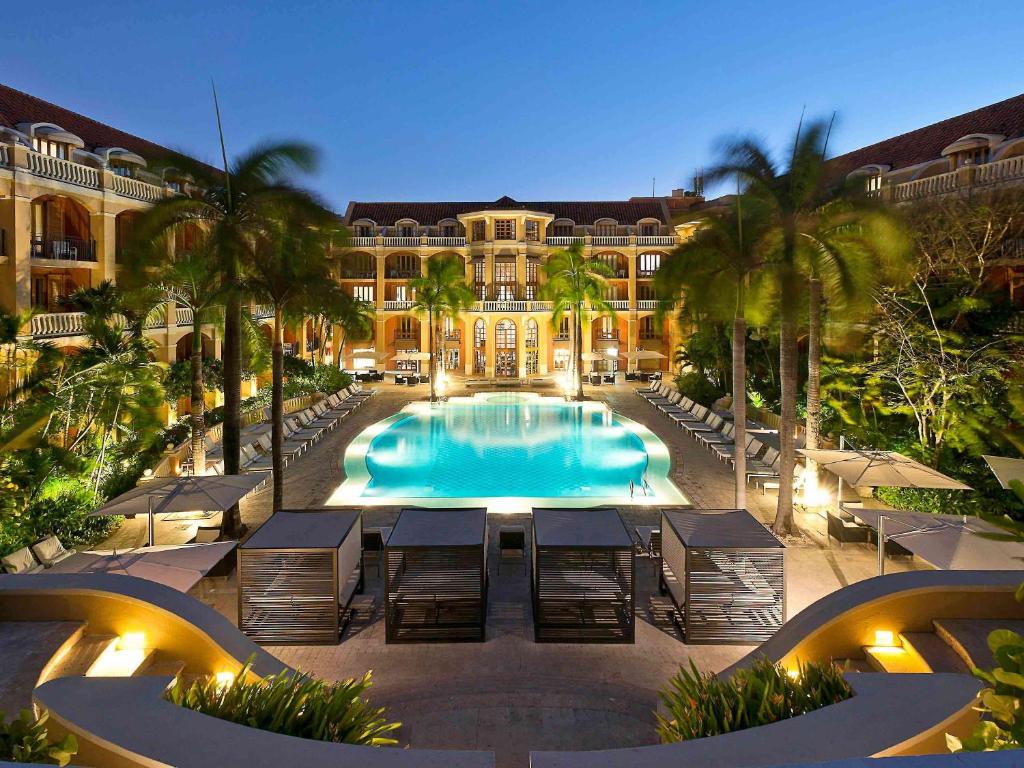
Sofitel Legend Santa Clara in Cartagena was built in 1621, originally functioning as a convent, so old-world charm is to be expected at this property. Over time, it’s also been a charity hospital, a prison, and a medical school before becoming the Santa Clara Hotel in 1995. This 5-star stay consistently makes the top hotels for accommodation when visiting Cartegena. After one look at its beautiful aesthetic, it’s easy to see why.
In addition to luxury rooms, and arguably the most comfortable beds, amenities include flat-screen TVs, free wifi, a gym, sauna, and spa facilities. You can also dine at one of two restaurants on-site–El Claustro and 1621. Room rates average $350-500 per night, making it the perfect pick for a special occasion or treat yourself getaway.
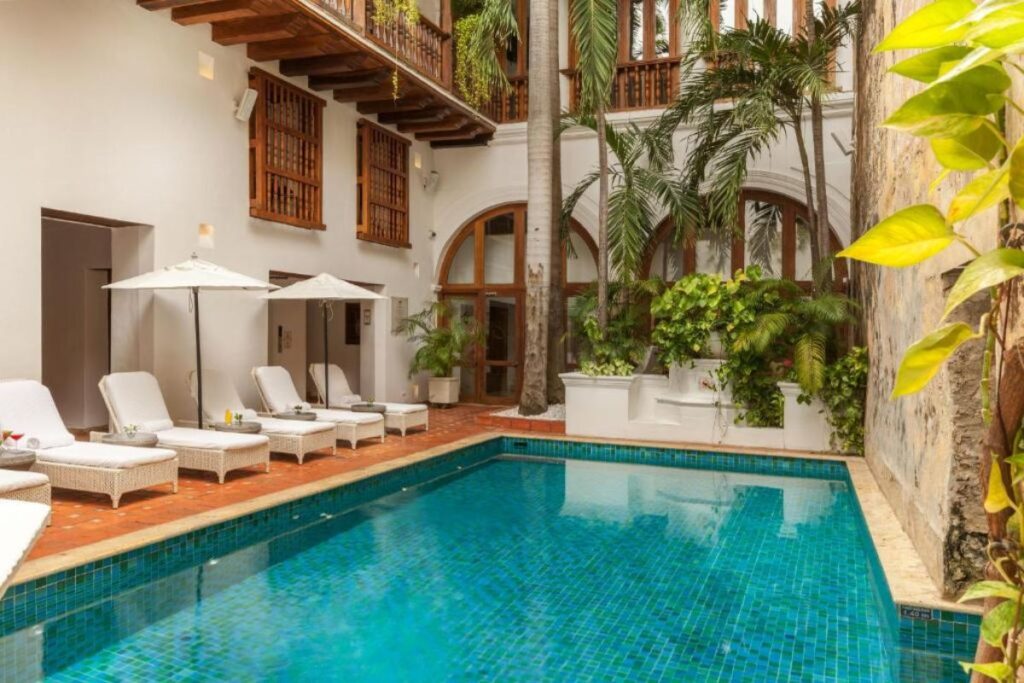
Hotel Casa San Agustin is for the luxury traveler who doesn’t mind paying for a premium accommodation. There’s plenty to do at this property for top-tier relaxing and luxuriating including an outdoor pool, solarium, game room, pool bar, and a restaurant. Set in a colonial home, Hotel Casa San Agustin also has a library for the bibliophiles among us.
Hotel Casa San Agustin is in demand, so booking far in advance is recommended. Nightly room rates start at $673 for a deluxe room, with the presidential suite going for $1,800+ per night. Nearby attractions include Santo Domingo and San Diego parks as well as Bocagrande and the Castillo Grande beaches.
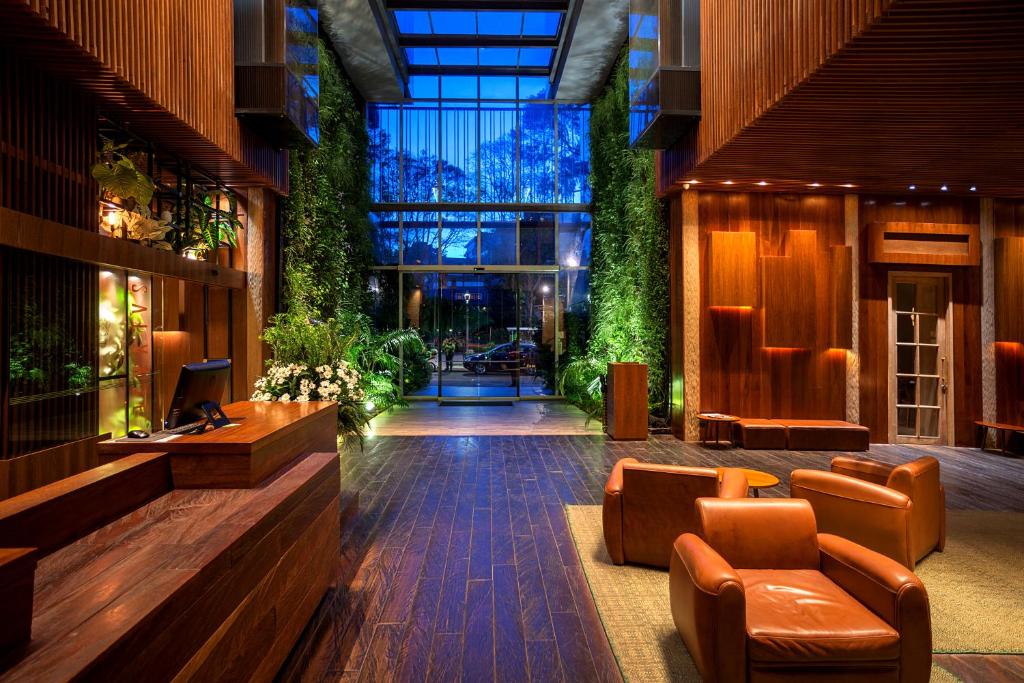
Located in the capital of Bogotá, Bioxury Hotel is a beautiful hotel that’s luxury adjacent but incredibly affordable. One Google reviewer even describes it as, “Arguably one of the best hotels in the country and definitely Bogota.”
The location is good too; it is safe to walk around, there is a mall within a 5-minute walk, and there are many restaurants around.
Tip: If you’re sensitive to sounds, be sure to ask for a room away from the bar on the first floor of the hotel.
My foodie girl dreams were fulfilled in Colombia. I can’t quite pinpoint if it was the endless options in our area of stay – El Poblado in Medellin – or the fact that I did have a decent number of meals that I wished I had the time to go back and try again.
From upscale Peruvian dinners to tons of casual cafes perfect for the morning email inbox sweep, there were so many great foods, beverages, and nightlife options to choose from, and all the more reason to visit again. Fresh fruits and vegetables. Some of the most tender meat I’ve ever had – so effortless. The temptation to eat out daily was real but I eventually made my way to the grocery store and opted for a better balance between meals at home vs. dining out.
Full transparency – I’ve heard others say they didn’t enjoy their food experience in Medellin but I didn’t have a single terrible meal. Maybe a few decent meals, but overall the lover of all things eating, aka me, ate my little heart out in Colombia.
Be sure to try these popular traditional Colombian foods during your visit.
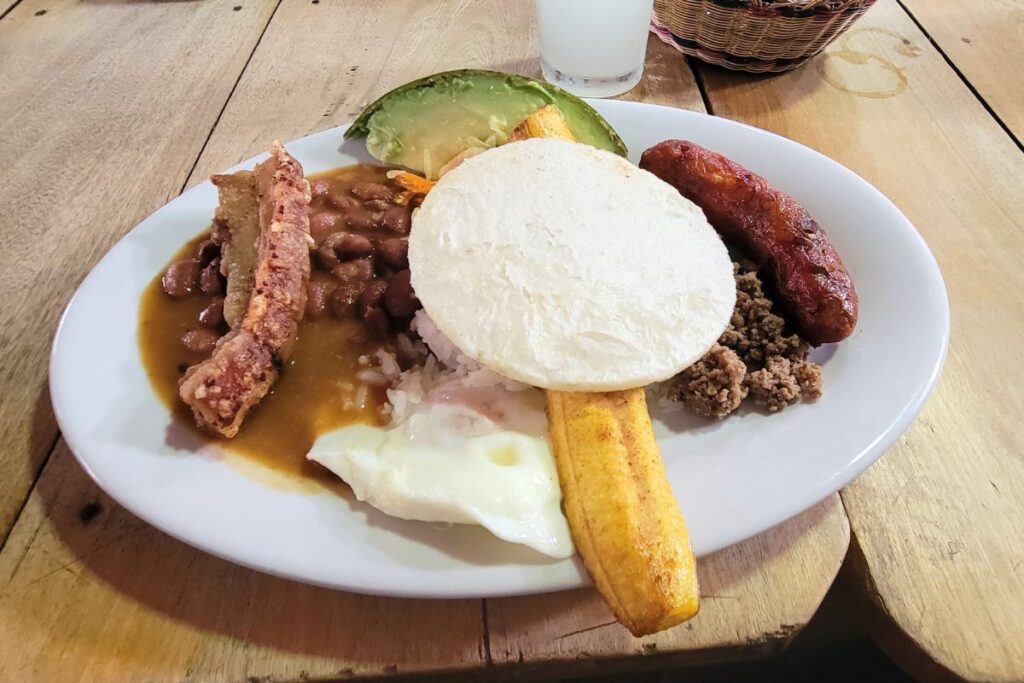
The popular dish consists of rice, minced meat, red beans, chorizo, arepa, a fried egg, chicharron (fried pork skin), morcilla (black pudding), sweet plantain, and a slice of avocado – all served on one plate.
Bandeja paisa is one of the most well-known foods in the whole country and is also considered to be a national dish. While you may not enjoy the homestyle presentation, this authentic dish is a great representation of the country and it’s pretty delicious.
One of the top signature street food items of Colombia is arepas. Made of deep-fried sweet cornmeal, arepas are somewhat similar to a tortilla. You’ll find arepas around Colombia served plain, with cheese, or as a complimentary side at take-out fried chicken restaurants.
If I’m being honest, which is my preference, I don’t particularly like arepas because they are usually dry and lacking in flavor. Maybe that’s the point so they can take the flavor of whatever you eat them with. Either way, when you’re visiting Colombia, you have to try arepas at least once and see for yourself.
When you need a savory street food snack, empanadas are the way to go. Empanadas are Latin America’s version of a turnover, made with yellow corn dough and stuffed with beef, pork, or potato.
They’re very similar to samosas, which you’ll find in India and Africa, but they have their own unique taste. Luckily, you can find them in nearly any restaurant which makes them a great go-to snack.
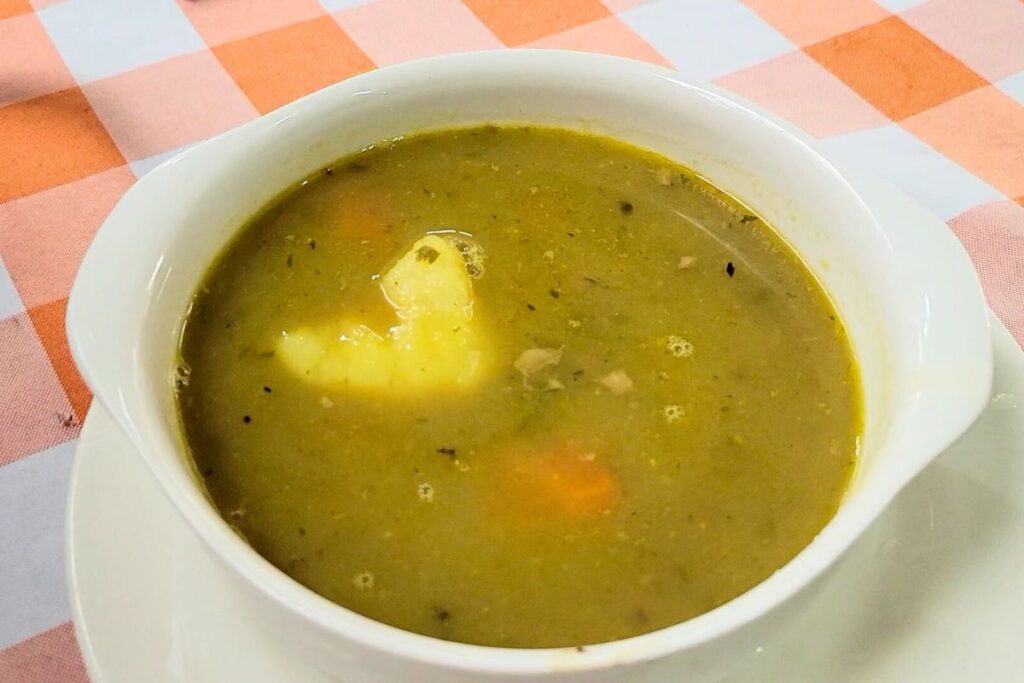
On cool or rainy days, ajiaco is the perfect soup to warm you from the inside out. The regional dish is common in Colombia, Cuba, and Peru, so you have to try it before you leave.
Ajiaco is typically made with different kinds of potatoes, spices, chicken, corn, and guasca leaves (Colombian herb). It also contains a variety of vegetables such as carrots, onions, scallions, and rice.
One of the best things about Colombia is the easy access to freshly-squeezed fruit juices – from actual fruits at that. Fresh fruit juice is a great alternative to eating fruit, although not any healthier. It can also reduce your risk of cancer, boost your immune system, remove toxins from your body, aid digestion, and help you lose weight.
Mora (local blackberry), guanabana (soursop), guayaba (guava), and lulo (an exotic fruit with a citrus flavor) are some of the most popular and delicious ones. Depending on the region, you may also find other exotic flavors like borojó, acai, nispero (Colombian kiwi), corozo (berry-like fruit), curuba (banana passion fruit), and zapote.
I had several people ask me if I felt “safe” while in Medellin. I can wholeheartedly acknowledge the existence of an outdated narrative that Colombia, specifically a city like Medellin, is dangerous, has gang activity, and drugs everywhere. Now, I can’t confirm these things don’t exist but I can tell you with 100% certainty that I didn’t experience them. We stayed in the El Poblado area, an area that’s digital nomad-friendly, so there was more activity than in a rural barrio or an area with fewer travelers.
As with any city, I’d always recommend traveling with others if you can. If you can’t, take an Uber or taxi. Walking is, of course, the last resort but that’s my perspective on most cities. El Poblado is pretty lively 7 nights a week so there are only a few hours where the streets get super quiet, but depending on where you’re staying, it might be best to consider an alternative to walking late at night. After all, the average Uber ride was less than or around $3 so I’d say that’s a great deal to get home (or to your hotel) safely.
Otherwise, the city treated me well and I had zero issues with locals, visitors, or anyone. If anything, the most dangerous part of my trip was the sidewalk that took me out one day walking back to the apartment (lol)… but that’s a story for another day.
Like any other destination, I always encourage women to make sure they travel to have fun but keep their safety in mind. I never felt unsafe during my time in Colombia.
There are also an increasing number of Black women nomading or expating to Colombia, so that’s good news. As such, private communities are popping up on Whatsapp and Facebook to help create community for these women to connect and gather.
As a general rule of thumb, I always encourage Black women to keep the following advice in mind, especially when traveling alone:
Overall, as a Black woman, I wouldn’t be any more concerned about safety in Colombia than I would be in the United States. I’ve been told that Cartegena and Bogota are both great cities but you have to be on guard a bit. I never felt that way in Medellin – everyone seemed friendly and helpful.
Generally speaking, yes, Colombia is safe for expats. Safety has improved significantly since the days of the reputation most people have in their heads about the country. The days of widespread drug cartel crime amid the reign of Pablo Escobar are long over. In its place, stands a resilient city that is actually safer than some U.S. cities according to the 2018 Numbeo Crime Index.
While safety might not be an issue, inflation is seriously impacting short-term rentals in Colombia, particularly in major cities. If you’re looking for a more affordable way of living, you’ll have to get crafty in certain areas as landlords seek top profits from American and other foreign travelers.
This recap only scratches the surface of all the lessons, experiences, and moments that I’m grateful for during my first visit to Colombia. I could go on forever about my time in this beautiful country. Instead, I’ll close with a few other activities to consider in your planning that are worth noting:
Brunch & Budget
Pockets Change
See Change Financial
Website Design & Strategy
Digital Marketing
Email Marketing (Newsletters)
Copywriting
Graphic Design
SC Creative Group (freelance)
From 2017 to 2021, I worked alongside the passionate team behind several brands to lead their website, email, and brand design strategy. What started as a 5-month marketing management project for one brand (covering brand asset consulting, advertising & social campaigns, social media and website design and strategy), expanded into 3-years of on-going collaboration across three brands in the financial education space.
The network of brands included: Brunch & Budget, affordable financial planning for people of color; Pockets Change, an organization that builds intergenerational financial resilience with students, families, and educators through hip-hop pedagogy; and See Change Financial, a radical financial community for creators of color who are taking control of their finances as a liberatory catalyst to lead value-filled lives.
During our 3-year client/consultant relationship, our work together supported the increased visibility and brand amplification they sought to achieve in unifying their brand message, mission, and visual identity.
We redesigned the site architecture, layout, copy, and visuals of each brand, creating an engaging, ever-updated online presence that kept each community informed and engaged. I also led the creation and implementation of marketing management systems including newsletter and social media content planning, design, and scheduling.
By helping Pam, Dyalekt, and Andrea (the creators) spend less time on promoting their business, they were able to lean into more programming and serving more educators, young adults, parents, and youth. In addition to re-purposing their decade-plus history of financial planning wisdom via their Brunch & Budget podcast, I also made sure during our time working together that they leveraged all opportunities to raise awareness, dollars (fundraising), and impact through storytelling.
One of the biggest achievements of supporting their brand growth goals came through a fundraising campaign for Pockets Change. After implementing a new donor engagement strategy and amplifying the initiative across platforms and partner networks at my recommendation, I helped the organization raise $19,000 in November 2021.
[Graphic Design] Social Media Content Management
During the era of social highlights via quote cards and brand-forward graphics and insights, I designed a set of social media templates for the team’s internal use. These templates helped onboard their interns into social media management while I supported by spearheaded strategy and copy for social and email behind the scenes.
Pockets Change Website Revamp Preview (2019)
Brunch & Budget Website Revamp Preview (2018)

Greenlight
Creative Strategy
Experiential Marketing
Copywriting
Fizz (Atlanta, Georgia)
Greenlight is a financial technology company on a mission to raise financially smart kids. Through its debit card for kids and application subscription, the company makes it easier for parents to teach their kids about money management while giving them a parent-monitored space to learning about things like saving, stocks, and direct deposits. The “all-in-one money app for families,” Greenlight gives kids independence while giving parents peace of mind.
The fintech company contracted Fizz, a word-of-mouth marketing agency based in Atlanta, to help expand brand awareness as it sought to increase users and identify ways to penetrate the market on a national scale for the first time.
As a contracted strategist, I worked alongside the in-house agency team to develop a robust creative WOM marketing strategy that included more than a dozen experiential digital and live brand activations. The goal of the overall strategy was to identify niche sectors within the broader target demographic and pinpoint opportunities (events, life moments, everyday activities, etc.) that would allow the brand to organically make life a little easier – as on-the-go parents and schedule-stacked kids – creating a chance to get curious and engage with GL market managers about the brand.
Working alongside the in-house strategy and design teams, my role was to develop word-of-mouth-marketing concepts into detailed experiences. This included researching a calendar of brand-aligned community and sporting events, developing a go-to-market plan for each concept, and presenting relevant branded swag ideas along with identifying vendors, costs, specs requirements, etc. to pass along to the project manager for execution.
The link below is a preview of one of the concepts I spearheaded the research, copywriting, and strategy development on. This concept was part of a larger word-of-mouth marketing strategy deck.
[Word-of-Mouth Strategy Concept] Greenlight ‘Very Invested Parents’ Strategy
Jim Ellis Automotive Group
Event Planning & Management
Vendor Procurement & Management
Budget Management
Copywriting
Design
Jim Ellis Automotive Advertising Agency
One of the joys of maintaining great professional relationships is being able to work with old employers on new initiatives. Jim Ellis Automotive Group is Atlanta, Georgia’s largest family-owned automotive group.
While the company’s marketing manager was out on maternity leave, I was tapped to step into her role. As the interim marketing manager, one of my responsibilities was to lead and execute the grand opening celebration of the automotive group’s 18th dealership – Jim Ellis Toyota of McDonough Grand Opening – a newly remodeled 57,000 square foot facility.
This project was exciting for a few reasons. Namely, the ability to lean into the breadth of my expertise. During this project, I led every aspect of the event, from securing vendors and media communications to run-of-show planning, invitations, and on-site management.
On Tuesday, May 21, 2019, Jim Ellis Automotive Group celebrated the official grand opening of Jim Ellis Toyota of McDonough. By all accounts, the affair was a successful introduction of the trusted Jim Ellis brand to Atlanta metro’s Southern region.
The event was well-regarded by those in attendance including Jim Ellis Automotive’s President, Jimmy Ellis, special guest executives from Toyota HQ, and – most importantly – the dedicated dealership staff, family, and friends. Special guests included Jim McEachern (Vice President, Southeast Toyota Field Operations) and Billy Copeland (Mayor of McDonough, GA).
The dealership’s acquisition and grand opening received media coverage locally and in notable national outlets including Business Insider and Auto Remarketing.
This project is a great example of my ability to work across teams, using my diverse background to easily navigate multiple corporate brand standards and guidelines, coordinate design projects, draft promotional and media-related communications, manage vendors (catering, event decor, entertainment, photo/video) and budgets, handle experiential logistics, and oversee on-site execution.
[Blog Post/Press Relase] Jim Ellis Automotive Group Acquires Toyota of McDonough
[Blog Post/Press Relase] Jim Ellis Automotive Celebrates the Official Grand Opening of Jim Ellis Toyota of McDonough


Jim Ellis Automotive Group
Event Planning & Management
Vendor Procurement & Management
Budget Management
Copywriting
Design
Jim Ellis Automotive Advertising Agency
One of the joys of maintaining great professional relationships is being able to work with old employers on new initiatives. Jim Ellis Automotive Group is Atlanta, Georgia’s largest family-owned automotive group.
While the company’s marketing manager was out on maternity leave, I was tapped to step into her role. As the interim marketing manager, one of my responsibilities was to lead and execute the grand opening celebration of the automotive group’s 18th dealership – Jim Ellis Toyota of McDonough Grand Opening – a newly remodeled 57,000 square foot facility.
This project was exciting for a few reasons. Namely, the ability to lean into the breadth of my expertise. During this project, I led every aspect of the event, from securing vendors and media communications to run-of-show planning, invitations, and on-site management.
On Tuesday, May 21, 2019, Jim Ellis Automotive Group celebrated the official grand opening of Jim Ellis Toyota of McDonough. By all accounts, the affair was a successful introduction of the trusted Jim Ellis brand to Atlanta metro’s Southern region.
The event was well-regarded by those in attendance including Jim Ellis Automotive’s President, Jimmy Ellis, special guest executives from Toyota HQ, and – most importantly – the dedicated dealership staff, family, and friends. Special guests included Jim McEachern (Vice President, Southeast Toyota Field Operations) and Billy Copeland (Mayor of McDonough, GA).
The dealership’s acquisition and grand opening received media coverage locally and in notable national outlets including Business Insider and Auto Remarketing.
This project is a great example of my ability to work across teams, using my diverse background to easily navigate multiple corporate brand standards and guidelines, coordinate design projects, draft promotional and media-related communications, manage vendors (catering, event decor, entertainment, photo/video) and budgets, handle experiential logistics, and oversee on-site execution.
[Blog Post/Press Relase] Jim Ellis Automotive Group Acquires Toyota of McDonough
[Blog Post/Press Relase] Jim Ellis Automotive Celebrates the Official Grand Opening of Jim Ellis Toyota of McDonough